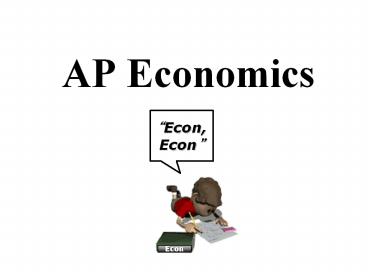AP Economics - PowerPoint PPT Presentation
Title:
AP Economics
Description:
AP Economics Econ, Econ Econ What is Economics in General? Economics is the study of _____. Economics is the science of scarcity. Scarcity is the condition in ... – PowerPoint PPT presentation
Number of Views:453
Avg rating:3.0/5.0
Title: AP Economics
1
AP Economics
Econ, Econ
Econ
2
What is Economics in General?
- Economics is the science of scarcity.
- Scarcity is the condition in which our wants are
greater than our limited resources. - Since we are unable to have everything we desire,
we must make choices on how we will use our
resources. - In economics we will study the choices of
individuals, firms, and governments.
- Economics is the study of _________.
choices
3
Examples You must choose between buying jeans
or buying shoes. Businesses must choose how many
people to hire Governments must choose how much
to spend on welfare.
Economics Defined
Economics-Social science concerned with the
efficient use of limited resources to achieve
maximum satisfaction of economic wants. (Study of
how individuals and societies deal with ________)
scarcity
4
Keep in Mind
McConnell and Brue, page 6- In spite of the
practical benefits, economics is mainly an
academic, not a vocational, subjecteconomics is
NOT primarily a how-to-make-money area of study.
5
Micro vs. Macro
MICROeconomics- Study of small economic units
such as individuals, firms, and industries
(competitive markets, labor markets, personal
decision making, etc.) MACROeconomics- Study of
the large economy as a whole or in its basic
subdivisions (National Economic Growth,
Government Spending, Inflation, Unemployment,
etc.)
6
Positive vs. Normative
How is Economics used?
- Economists use the scientific method to make
generalizations and abstractions to develop
theories. This is called theoretical economics. - These theories are then applied to fix problems
or meet economic goals. This is called policy
economics.
Positive Statements- Based on facts. Avoids value
judgements (what is). Normative Statements-
Includes value judgements (what ought to be).
7
Thinking at the Margin
Times Watching Movie Benefit Cost
1st 30 10
2nd 15 10
3rd 5 10
Total 50 30
Would you see the movie three times? Notice that
the total benefit is more than the total cost but
you would NOT watch the movie the 3rd time.
8
Marginal Analysis
In economics the term marginal additional
Thinking on the margin, or MARGINAL ANALYSIS
involves making decisions based on the additional
benefit vs. the additional cost.
For Example You have been shopping at the mall
for a half hour, the additional benefit of
shopping for an additional half-hour might
outweigh the additional cost (the opportunity
cost). After three hours, the additional benefit
from staying an additional half-hour would likely
be less than the additional cost.
9
Marginal Analysis
Notice that the decision making process wasnt
should I go to the mall for 3 hours or should I
stay home
In reality the decision making process started
with should I go to the mall at all. Once you
are there you thought should I stay for an
additional half hour or should I go.
The MARGINAL ANALYSIS approach to decision making
is more comely used than the all or nothing
approach.
10
Marginal Analysis
Notice that the decision making process wasnt
should I go to the mall for 3 hours or should I
stay home
You will continue to do something until the
marginal cost outweighs the marginal benefit.
In reality the decision making process started
with should I go to the mall at all. Once you
are there you thought should I stay for an
additional half hour or should I go.
The MARGINAL ANALYSIS approach to decision making
is more comely used than the all or nothing
approach.
11
5 Key Economic Assumptions
- Societys wants are unlimited, but ALL resources
are limited (scarcity). - Due to scarcity, choices must be made. Every
choice has a cost (a trade-off). - Everyones goal is to make choices that maximize
their satisfaction. Everyone acts in their own
self-interest. - Everyone acts rationally by comparing the
marginal costs and marginal benefits of every
choice - Real-life situations can be explained and
analyzed through simplified models and graphs.
12
Graphs
13
Scarcity































